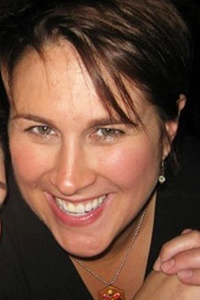
About
Ahna Skop is a geneticist, artist and a winner of the prestigious Presidential Early Career Awards for Scientists and Engineers (PECASE). Her lab seeks to understand the molecular mechanisms that underlie cell division during embryonic development using the nematode, C. elegans as a model system. Failures in cell division often lead to birth defects, cancer, and age-related neurodegenerative diseases. Understanding how cells divide is highly dependent on in vivo microscopy and large amounts of visual data, which dovetails perfectly with one of her other passions, art. The combination of scientist and artist inspires her to think differently and maintain an open mind. Some of her work can be seen in the main entrance of the Genetics/Biotechnology Center building on the UW-Madison campus. She has also curated and contributed to a traveling exhibition of scientific art called "TINY: Art from microscopes" from the UW-Madison campus and she has organized the bi-annual Worm Art Show for the International C. elegans Meeting since she was a graduate student. Ahna, who is part Eastern Band Cherokee, is also passionate about increasing the numbers of underrepresented students in STE(A)M fields. On the UW-Madison campus and in her department, she has established several very successful recruitment and retention programs and served two consecutive terms as the Chair of Equity and Diversity in the College of Agriculture and Life Sciences (CALS). During this time, she received Sloan Foundation support to create and manage the STEM Diversity Network (stemdiversity.wisc.edu) with goals to connect students with campus advocates. In 2016, she was awarded the very first of two, Chancellor's Inclusive Excellence Award for her outreach and inclusive teaching efforts. She has served as a board member for SACNAS (Society for the Advancement of Chicanos and Native Americans in Science) and was recently elected to the ASCB (American Association for Cell Biologists) Minority Affairs Committee where she has broadened her impact on underrepresented students in science nationally.
Ahna is the child of artists. Her father, Michael Skop, was a bit of a Renaissance man and was a classically trained fine artist who studied with Mestrovic (a pupil of Rodin) and also taught college-level anatomy. Her father operated an art school at their home studio for over 30 years and attracted artists, musicians, and philosophers from all over the world. Her mother was a high school art educator, ceramicist, and has dabbled in fiber art, sculpture and painting. Her two sisters and brother are also graphic and industrial designers. She has embraced her parents' love of creativity in everything she does. She majored in biology and ceramics at Syracuse University (1990-1994), where her father had played football and studied with Mestrovic. She received her Ph.D. in Cell and Molecular Biology at the University of Wisconsin-Madison (1994-2000) and conducted her post-doctoral work at UC-Berkeley (2000-2003).
Ahna is a Professor in the Departments of Genetics and an affiliate faculty member in Life Sciences Communication and the UW-Madison Arts Institute at University of Wisconsin-Madison. She mentors both scientists and art students in her lab, and also serves on the board of the Wisconsin Science Museum, where many of her art-science collaborations are on display. In 2008, she was awarded an honorary doctorate of science from the College of St. Benedicts and was named a Remarkable Women in Science from the AAAS. In 2015, she was honored as a Kavli Fellow from the National Academy of Sciences. Her science and art have been featured by Apple, The Scientist, USA Today, Smithsonian, PBS.org, NPR and Science magazine. One of her great hobbies is cooking/baking (including scientific cakes!) and she manages a foodblog, foodskop.com, in her free time.
Education
- BS, Biology, Ceramics minor, Syracuse University
- PhD, Cell and Molecular Biology, University of Wisconsin-Madison
- Post-doctoral work at UC-Berkeley
Research Description
The Skop lab seeks to understand the molecular mechanisms that underlie cell division during embryonic development using the nematode, C. elegans as a model system. Failures in cell division often lead to birth defects, cancer, and age-related neurodegenerative diseases. Understanding how cells divide is highly dependent on in vivo microscopy and large amounts of visual data, which dovetails perfectly with one of her other passions, art. The combination of scientist and artist inspires her to think differently and maintain an open mind. Some of her work can be seen in the main entrance of the Genetics/Biotechnology Center building on the UW-Madison campus. She has also curated and contributed to a traveling exhibition of scientific art called "TINY: Art from microscopes" from the UW-Madison campus and she has organized the bi-annual Worm Art Show for the International C. elegans Meeting since she was a graduate student. Ahna, who is part Eastern Band Cherokee, is also passionate about increasing the numbers of underrepresented students in STE(A)M fields.
Affiliations
- Affiliate, Life Sciences Communication
- Affiliate, UW-Madison Arts Institute
- Board Member, Wisconsin Science Museum
Honors
- PECASE (2006)
- Remarkable Woman in Science (2008)
- Kentucky Colonel (2008)
- Honorary Doctorate of Science (D.Sc.), College of St. Benedict (Minnesota) (2008)
- Kavli Frontiers in Science Fellow, National Academy of Sciences (2015)
- Chancellor's Inclusive Excellence Award in Teaching (2016)
- SACNAS/AAAS LPSLI Fellow (2017)
